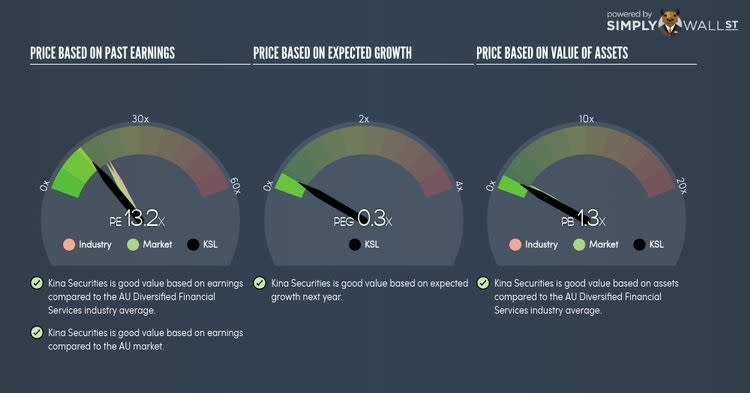November Top Undervalued Stock

Companies, such as Kina Securities, are deemed to be undervalued because their shares are currently trading below their true values. There’s a few ways you can measure the value of a company – you can forecast how much money it will make in the future and base your valuation off of this, or you can look around at its peers of similar size and industry to roughly foresee what it should be worth. Below, I’ve created a list of companies that compare favourably in all criteria based on their most recent financial data, making them potentially good investments.
Kina Securities Limited (ASX:KSL)
Kina Securities Limited provides a range of financial products and services in Papua New Guinea. Started in 1985, and currently run by Greg Pawson, the company now has 300 employees and with the stock’s market cap sitting at AUD A$126.27M, it comes under the small-cap group.
KSL’s stock is now trading at -36% lower than its true level of PGK1.2, at a price of PGK0.77, based on my discounted cash flow model. The discrepancy signals an opportunity to buy low. Additionally, KSL’s PE ratio stands at 13.2x while its diversified financial services peer level trades at 18.3x, indicating that relative to its comparable set of companies, KSL can be bought at a cheaper price right now. KSL is also strong financially, with short-term assets covering liabilities in the near future as well as in the long run. KSL also has a miniscule amount of debt on its balance sheet, which gives it headroom to grow and financial flexibility.
Legend Corporation Limited (ASX:LGD)
Legend Corporation Limited provides engineering solutions in Australia and New Zealand. Legend was established in 1962 and with the company’s market capitalisation at AUD A$43.66M, we can put it in the small-cap category.
LGD’s stock is now trading at -60% under its intrinsic level of $0.49, at the market price of $0.2, based on my discounted cash flow model. This discrepancy gives us a chance to invest in LGD at a discount. In terms of relative valuation, LGD’s PE ratio is around 11.8x relative to its trading companies and distributors peer level of 12.6x, suggesting that relative to its competitors, we can invest in LGD at a lower price. LGD also has a healthy balance sheet, with short-term assets covering liabilities in the near future as well as in the long run. It’s debt-to-equity ratio of 28% has been reducing over the past couple of years indicating LGD’s ability to pay down its debt.
Atlas Iron Limited (ASX:AGO)
Atlas Iron Limited, an independent iron ore company, explores for, develops, mines, and sells iron ore in the Pilbara region in Western Australia. The company currently employs 300 people and with the stock’s market cap sitting at AUD A$167.03M, it comes under the small-cap group.
AGO’s shares are now hovering at around -55% less than its intrinsic value of $0.04, at the market price of $0.02, according to my discounted cash flow model. The mismatch signals a potential chance to invest in AGO at a discounted price. Also, AGO’s PE ratio stands at around 3.4x while its metals and mining peer level trades at 13.8x, implying that relative to its competitors, we can buy AGO’s stock at a cheaper price today. AGO is also robust in terms of financial health, with current assets covering liabilities in the near term and over the long run. Finally, its debt relative to equity is 33%, which has for the past few years showing AGO’s capacity
For more financially sound, undervalued companies to add to your portfolio, you can use our free platform to explore our interactive list of undervalued stocks.
To help readers see pass the short term volatility of the financial market, we aim to bring you a long-term focused research analysis purely driven by fundamental data. Note that our analysis does not factor in the latest price sensitive company announcements.
The author is an independent contributor and at the time of publication had no position in the stocks mentioned.



